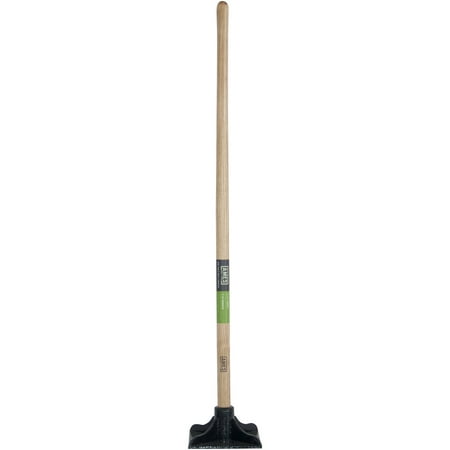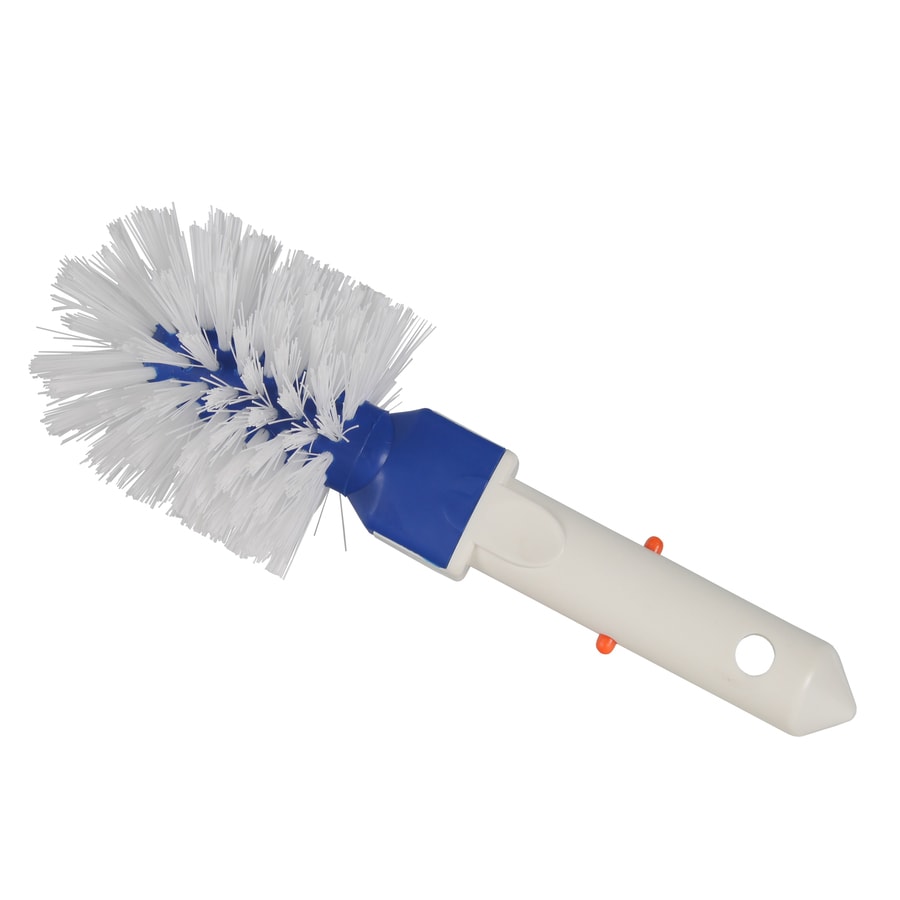I was wondering how ya’ll clean your track, ballast and level it for running and open house? I use a small blower to take care of the leaves (so I will not blow the existing ballast away) but it takes getting down where the track is to ballast and level it. Just wondering how ya’ll do it.
I get the track in the approximate spot with wood blocks or whatever… then drop ballast in a few spots and basically swap it for the blocks… once those areas are right, fill in the rest with ballast.
I work the ballast in with a hose sprayer then check level… eyeball mostly, but over long distances a laser unit…
Raising track is easy, pour ballast over it, and then reach through the ballast and lift the track a bit.
Lowering, I use the hose on “stream” and then a 8 inch square garden “tamper”…

Clearing the ballast from between the ties is a round bottle brush type of brush, used to clean corners in pools… mounts to a pole

moving a lot of ballast with a small 6" wide rake… (the one shown is 8")

Greg
I use a 3 inch turbo fan to clean away debri, and a LGB track cleaner with a Zimo decoder to clean my brass rails. I can clean running both forward and backwards now.
Being in the Northeast USA I use 2 SD45 to push an Aristocraft snow plow.
So you guys do not worry about the track being level?
did you miss the part where I mentioned a laser level?
Greg
Pour mans laser… (http://www.largescalecentral.com/externals/tinymce/plugins/emoticons/img/smiley-wink.gif)
My layout is not level, trains change speed as the go up and down on the small grades just like the real ones.
Here in the northeast one can not keep track on the ground level due to the 2 foot plus frost line!!
The first thing I do is get tangent (straight) track straight. You can normally do this by sighting down the track… you can shoot a laser if you want too.
Next I make sure my curves are smooth, and I have a rail bender that I can do this in place.
Now, I get down at the level of the track and look for humps and dips… and fill or lower. I have free floating track, so this is pretty easy.
Next, an Aristo Mikado around the track and look at the boiler. Since these locos have absolutely no suspension to speak of, and a long driver wheelbase, you can see the level of the boiler as you have humps and dips.
At this point your track should be reasonable. Now you want to check cross level just to be sure… a flat car with a level on it, and one truck screwed down so it cannot flex side to side (the other truck loose). Put a small level crosswise on the car and watch. Really bad crosslevel will be obvious from looking at the car itself. The level will confirm.
I check long sections with a laser and a stick to the track, so I can catch gradual rises or declines I don’t want.
Bottom line, if you get down at track level, most defects can be seen.
Greg
I use my highly calibrated Seaman’s eye to do the rough in, then i run a train over it, marking where it seems to wobble. Then i get out a 4 ft level for the straights, and a short, 6 inch level to check side to side level.
If you pay attention, you will be surprised at how accurate your eye can be.
Lasers? Well, we are still in the 19th century here.

A 2 foot level with a step block for grade, and a torpedo level (that yellow thing) for side to side elevation.
Ballast spreader;

Nylon and the cheapest brush this style on the rack.
Side to side level;

The angle display makes viewing from above easier. Slide along rails.The illustration was the 1st seen not my choice per say.
The level has magnets in the base and I use a metal straightedge for longer measurements
I use the level to verify my eye. I also use it to set super elevation despite many recommendations against it. Chuck N’s mallet ran just fine on my layout several years ago(https://www.largescalecentral.com/externals/tinymce/plugins/emoticons/img/smiley-wink.gif).
Lifting with a shake or pushing down with a shake reduces ballast tensions allowing the track to move smoothly into position.
Make sure it measures in percentage, the Railroad way.
Ballast
Where I live was once an ocean floor on top of that I’m surrounded by mountains that are half their size. Having eroded and crumbled onto the desert below. Every summer we get monsoon rains where a half an inch can fall in an hour or less. Around my house are hills and as the water slows transitioning from hill to flat the largest gravel bits drop out first. I get coarse sand and fractured stone (hot and cold cycles). No where as good as crusher fines, it does hold better than gravel and besides my looking goofy as I sweep my dirt driveway, it’s free and the supply is endless!(https://www.largescalecentral.com/externals/tinymce/plugins/emoticons/img/smiley-money-mouth.gif) I sweep up piles and on a windy day I winnow out the dirt and eliminate big stuff with 1/4" hardware cloth over the bucket.
Can’t beat Free John. My first outdoor loop was ballasted with winter road grit swept up in the spring from the cul-de-sac out front. They stopped putting down “sand” on my road the next year so I resorted to paying for it.
Jon Radder said:
Can’t beat Free John. My first outdoor loop was ballasted with winter road grit swept up in the spring from the cul-de-sac out front. They stopped putting down “sand” on my road the next year so I resorted to paying for it.
I like gutter sand! I used to get super fine ‘scale’ sand there.(https://www.largescalecentral.com/externals/tinymce/plugins/emoticons/img/smiley-laughing.gif)
Greg, I did.
I have spikes a 4’ level distance apart for a center line and work off those to keep my track straight. I eyeball it in between the spikes. I have a small level I use to check the cross level. My track floats like Greg’s so it is always moving especially in the curves.
Ron Hill said:
Greg, I did.
Ron
I pretty much do like you stated however I’m kinda careful with the leaf blower. Yes it will blow ballast but it’s all about properly handling the blower. Perhaps it’s an art ? As for leveling, the 1:1 follows the terrain and so do I . However I do re ballast every couple years here in PA.
Hope this helps
I have a variable speed battery powered blower, works well, also a small Black and Decker one that also works great but they don’t sell them anymore:

nice and gentle and just about the width of the track.
Thanks for all the imput on this topic. I did get the layout ready including a new 52" steel bridge, but got rained out. Will work for next year.